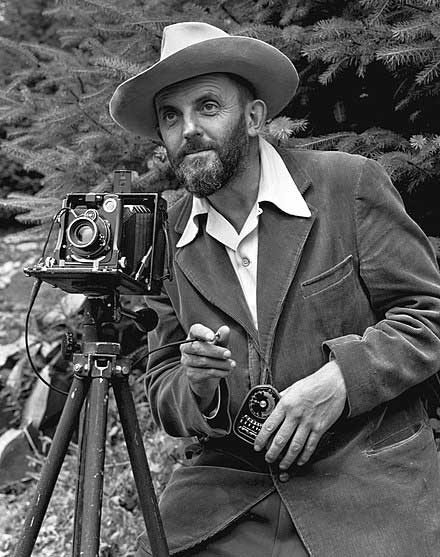Ansel Adams is one of the greatest photographers in history, mostly known for all for his black and white photographs of nature, and for being the creator of the zone system. An interesting and daring character, he’s possibly one of the photographers with the biggest contributions for the world of photography. His images favored many to adapt to the idea that photography can be a means of expression.
Ansel Adams was born on February 20, 1902 in San Francisco, United States. His childhood was marked by the many moments he had to keep bed due to his predisposition to get sick.

Interestingly, the disease was responsible for Ansel’s interest in photography. In his autobiography, he explained that when he became ill with Measles at age 12 and had to remain in his room with the shutters closed, he observed the phenomenon of image formation with the light passing through the little space of the shutters. The phenomenon was later explained by his father in more detail using a camera. That first contact with the world of photography marked his destiny.
«You don’t make a photograph just with a camera. You bring to the act of photography all the pictures you have seen, the books you have read, the music you have heard, the people you have loved.»
At that same age, attracted by his mother’s hobby, he began to study piano, art that gave him discipline and structure. Ansel was a nature enthusiast thanks to a book his aunt gave him about Sierra Nevada, so he encouraged his family to spend their vacations in Yosemite National Park, the place that would be significant for his career as a photographer. Shortly after arriving in Yosemite, he was given his first camera, a Kodak Box Brownie.
In 1918, when he turned 16, Adams worked part-time in a photo service store near his home. During the summer of that year he made his first alone visit to Yosemite. A year later, he became a member of the Sierra Club, an environmental organization to which he actively belonged until his death. His entry into the club accentuated his interest in photography, where he used to take his large format Graflex camera to all his excursions.
Adams, who had tried to make a career as a piano concert performer, began to see photography not only as something lucrative, but also something he would like to make a living from. His first success was to obtain financing for a trip to the Rocky Mountains of Canada as an official photographer. From the age of 18 he was already beginning to show doubts about his planned career as a piano concert performer and his newly discovered love for photography.
«The whole world is, to me, very much «alive» – all the little growing things, even the rocks. I can’t look at a swell bit of grass and earth, for instance, without feeling the essential life – the things going on – within them. The same goes for a mountain, or a bit of the ocean, or a magnificent piece of old wood.»
This dilemma that accompanied him for years, and the intense need to sell his photographs, led him to the studio of Harry Cassie Best, a landscape painter who had found a market for his paintings of Yosemite.
In 1927, his friend Cedric Wright introduced him to Albert Bender, a committed sponsor of the arts. Bender introduced Ansel into the cultural environment of San Francisco and achieved the publication of a collection of his photographs: Parmelian Prints of the High Sierras.
On one of his trips with Bender he met Paul Strand, whose images caused him great impact and helped him to move away from the pictoralist style towards the style of “straight photography” (direct or pure photography), where the clarity of the lens is the most important and where photography has to suffer the least number of adjustments possible.
«There are no forms in nature. Nature is a vast, chaotic collection of shapes. You as an artist create configurations out of chaos. You make a formal statement where there was none to begin with. All art is a combination of an external event and an internal event… I make a photograph to give you the equivalent of what I felt. Equivalent is still the best word.»
In 1932, together with Imogen Cunningham and Edward Weston, they created the F64 group. All of them were photographers who defended the detail and naturalistic aesthetics. The components of this group innovated in the field of photographic procedures, the most important being the zone system developed by Adams, who was the expert in controlling photographic exposure.
In 1933 he traveled to New York and meets Alfred Stieglitz, with whom he began a great friendship and who would earn him future works in magazines such as Fortune or Life.
In 1939 he created the first photography department at the California School of Fine Arts, and published a collection of ‘essential books on photography about photographic techniques’. He also worked on behalf of the companies Kodak, IBM and AT&T, in addition to being an advisory photographer at Hasselblad.
In 1941, he was hired by the Department of Interior of the US Government for a photographic project in which he had to portray the natural parks and aboriginal reserves, among other places. These photographs were meant to decorate a new building that was under construction.
In 1949 he was in charge of testing the first prototypes of Polaroid, something that he developed with enthusiasm to discover the new possibilities offered by the system.
Adams died from cardiovascular disease on April 22, 1984 in California, at age 82.






